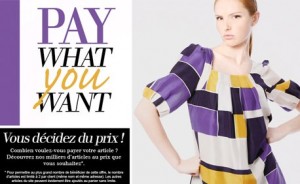Letting people pay what they want, with the promise that 50% will go to charity, produces a higher profit than selling the product at a fixed, market price. It also earns more money for the nonprofit
Leif Nelson, an associate professor of marketing at the Haas School of Business at UC Berkeley, ran an experiment to test this hypothesis at a large amusement park. He tested 28,224 people against four conditions to gauge how much they would pay for an action picture of themselves on a rollercoaster.
The four conditions were: Would you pay the asking price of $12.95? Would you pay $12.95 if half went to a nonprofit? What would you pay if you could name your price? and What would you pay if you could name your price and half of it went to a nonprofit?

In Dollars and Cents
Nelson found that only half of 1% of rollercoaster riders who were offered the photo for $12.95 bought the picture, generating a profit of 6 cents per visitor. When half of the $12.95 was promised to charity, only slightly more riders bought it, generating about 7 cents per visitor. The philanthropic element did increase demand, but just marginally.
When riders were able to name their price, more people bought the picture (8.4%) but paid significantly less (92 cents on average, less than the production cost, which caused a loss).
When riders choose their price, knowing that a nonprofit would benefit, 4.5% chose to buy the picture. This figure is lower than the pay-what-you-want non-charity option, but higher than either fixed-price condition. But the thrill is in what riders forked up: an average of $5.33, or nearly 20 cents in profit per visitor (compared to 6 cents in profit at the fixed coast), as well as more money for the nonprofit.
In short, people will pay more when they can choose their price and know that a nonprofit benefits from their decision. This pricing and partnership model is the most lucrative for a company and also produces the highest funds for a nonprofit.
According to Leif, choice is key to the success of the model. Providing customers more choice–like selecting the nonprofit beneficiary–could earn even more dollars for the company and the nonprofit.
What Does This Mean For You?
- It’s worth trying! Although we’re seeing more companies adopt pay-what-you-want models, either in their entirety (One World Everybody Eats, Panera Bread or SAME) or in part (Radiohead’s “In Rainbows” album or Mixergy’s subscription option), the model is still fringe and viewed a bit as black magic.
. - Be clear about what you expect. Is it greater net profits? More consumers? A stronger mechanism for social impact? More effective nonprofit partnership? Per Leif’s research you won’t attract more consumers, at least not initially, but you will earn more profits and have a deeper social impact.
. - This study hinged on 50% of sales channeled to a nonprofit. I don’t know how it would work with a lower (or higher) donation amount, so be aware of varying results if you try different percentages.
. - Beware the paralysis of choice. Leif suggests that giving customers more choice might generate greater results. Again, it’s worth testing by offering a limited number of choices to the consumer. As in all marketing (even more so when it’s cause-related), keep it simple. Too many choices, contingencies and selling points is paralyzing to the consumer.
If you’ve tried something like this or know of other businesses who have (even companies that use a non-charity pay-what-you-want model), please let me know in the comments, on Twitter (@OKL) or through email, olivia[at]causecapitalism.com.
*”Shared Social Responsibility: A Field Experiment in Pay-What-You-Want Pricing and Charitable Giving” published by Leif and his colleagues appeared in the July 2010 issue of Science magazine.





 I'm Olivia Khalili. I created Cause Capitalism to show you how to grow your business by incorporating a social mission.
I'm Olivia Khalili. I created Cause Capitalism to show you how to grow your business by incorporating a social mission. 
